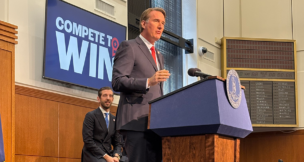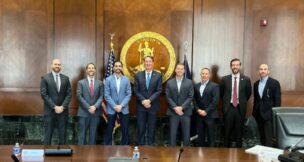
In February, national trucking activity grew by 3% compared to January, the largest monthly increase in years. Photo courtesy Port of Virginia

In February, national trucking activity grew by 3% compared to January, the largest monthly increase in years. Photo courtesy Port of Virginia
Truckers hope freight recession is finally ending
Mason Adams //April 30, 2025//
Virginia truckers hope President Donald Trump will bring the industry some regulatory relief and spark a comeback after a protracted freight recession.
During the height of the COVID-19 pandemic, the trucking industry surged, driven by growing numbers of people ordering consumer goods from home.
“When consumers are buying things, that’s good for trucking because we need to move it and bring it to them,” says Dale Bennett, president and CEO of the Virginia Trucking Association. “Coming out of COVID, once things started opening up, people started shifting more to experiences — going out to concerts, taking vacations, escaping from cabin fever. While trucking is needed to support all these experiences, it’s not nearly as good for us as people buying goods that we transport.”
Inflation and a sudden increase in open capacity further dragged on the trucking industry.
But in February, trucking activity perked up and grew 3% compared to January, the largest monthly increase in several years, according to the American Trucking Associations.
Carriers seemed generally optimistic after Trump’s presidential victory in November and anticipated a rollback of federal regulations, especially those requiring lower emissions and a shift toward electric vehicles. His emphasis on tariffs, though, has created some uncertainty. In early April, Trump declared a 10% baseline tax on imports from all countries and higher tariffs on some nations, including 34% on China, risking a broader trade war.
ATA President and CEO Chris Spear said in April that truckers hauling goods between the U.S., Mexico and Canada “will bear a direct and disproportionate impact” from tariff wars.
“Almost all cross-border traffic goes by truck,” Bennett says. “We’re hopeful that the Trump administration’s strategy will result in a quick resolution of the issue. Let’s get it resolved.”
The uncertainty caused by Trump’s sporadic tariff threats leaves questions about whether February’s bump in trucking activity really signaled the end of the U.S. freight recession, or if it’s a blip.
“This has been the longest freight recession we’ve had,” says Devon Anders, president of Rockingham County third-party logistics company InterChange. “It’s started to come back, but then it hasn’t. The prediction was freight would come back strong this year, and now there’s a little bit of a question if we’ll pull out of it.”
There’s more confidence Trump will lift regulations on the trucking industry. He already has issued executive orders to roll back Biden-era clean energy spending and environmental regulations, and Trump says he will bring back less stringent auto emissions standards.
“That is something we fought under the Biden administration, and we’re hoping we’re going to have a better chance for our side of the issue to be heard,” Bennett says.
Trucking advocates say the industry already is moving toward fewer emissions and cleaner vehicles.
“Compare a new truck today to one in 2010; its emissions are 40% less,” Bennett says. “We’ve got a great story to tell about how we’ve worked hard and invested money to reduce our emissions.”
Some of truckers’ problems with federal and state emissions restrictions come from their timeline. A rollback helps with “not having to switch out equipment as quickly,” Anders says. “The changes cost a lot, which drives up the cost of trucking.”
California withdrew its request for a federal waiver for its Advanced Clean Fleets rule, which would have required a shift to emissions-free vehicles by 2036. Virginia’s policy is similar, but the state granted an exemption for trucks over seven tons.
Bennett says that California’s goals “are not realistic and not achievable given the current state of battery electric technology for heavy-duty trucking and the lack of charging infrastructure. To force it is not good for the industry and not good for the supply chain.”
T
















